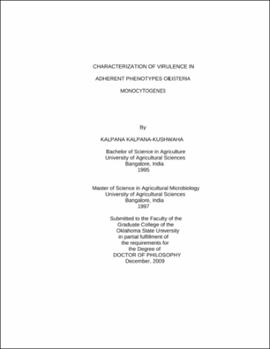| dc.contributor.advisor | Muriana, Peter | |
| dc.contributor.author | Kalpana, Kalpana-Kushwaha | |
| dc.date.accessioned | 2013-11-26T08:22:35Z | |
| dc.date.available | 2013-11-26T08:22:35Z | |
| dc.date.issued | 2009-12 | |
| dc.identifier.uri | https://hdl.handle.net/11244/6602 | |
| dc.description.abstract | Scope and Method of Study: | |
| dc.description.abstract | Listeria monocytogenes is a food borne pathogen and a recurring problem in ready-to-eat (RTE) meat, raw meat and meat processing facilities. We examined 246 strains of Listeria isolated for over 1 year from 3 RTE meat processing facilities for their adherence phenotype using microplate adherence assay, used PCR to identity those that were L. monocytogenes and further typed using pulsed-field gel electrophoresis. The adherence and virulence capacity of the select strains isolated from raw and RTE meat was tested in vitro using human cell line Caco-2 and in vivo by oral inoculation into A/J mice. Further, spleen and liver tissue samples were subjected to necropsy to confirm the virulence. Subtyping was done using MLST, PFGE and RT methods to see if molecular typing methods could segregate the adherent phenotypes into different groups. | |
| dc.description.abstract | Findings and Conclusions: | |
| dc.description.abstract | Strains of Listeria isolated from three RTE meat processing plants were distinguished as strong and weakly adherent based on assay. The data showed that Plant C had almost 4x the prevalence of Listeria isolates when compared to Plants A or B indicating the significance of adherence. The use of PFGE fingerprint analysis was informative in suggesting that similar strains were isolated repeatedly within the same facility on the same day or on different dates as recurring isolates. Cell culture virulence assay carried out for four strong and four weakly adherent strains isolated from raw and RTE meat showed higher invasion for strains capable of strong adherence to abiotic surfaces with low incubation time and low multiplicity of infection. In vivo study showed bacterial recovery in spleen and liver by strongly adherent strains whereas weakly adherent strains were completely eliminated from liver. This was further confirmed by significant histological lesions in the liver samples caused by strongly adherent strains. Adherence properties of L. monocytogenes may allow persistence and recurrence in plant environments, potentially increasing the chance of eventual product contamination. The presence of generic Listeria spp. is significant as it represents a failure of sanitation hurdles to eliminate these organisms from the processing environment, and even more so if they are L. monocytogenes, as they are human pathogens. Therefore, elimination of strongly adherent strains of L. monocytogenes from food processing environment deserves special attention as their strong adherence not only promotes retention but may show enhanced invasion and replication in host tissues causing greater virulence | |
| dc.format | application/pdf | |
| dc.language | en_US | |
| dc.rights | Copyright is held by the author who has granted the Oklahoma State University Library the non-exclusive right to share this material in its institutional repository. Contact Digital Library Services at lib-dls@okstate.edu or 405-744-9161 for the permission policy on the use, reproduction or distribution of this material. | |
| dc.title | Characterization of virulence in adherent phenotypes of Listeria monocytogenes | |
| dc.contributor.committeeMember | Gilliland, Stanley | |
| dc.contributor.committeeMember | DeWitt, Christina | |
| dc.contributor.committeeMember | McGlynn, William | |
| osu.filename | Kalpana_okstate_0664D_10550.pdf | |
| osu.accesstype | Open Access | |
| dc.type.genre | Dissertation | |
| dc.type.material | Text | |
| dc.subject.keywords | adherence | |
| dc.subject.keywords | cell culture | |
| dc.subject.keywords | listeria | |
| dc.subject.keywords | microplate fluorescence assay | |
| dc.subject.keywords | subtyping | |
| dc.subject.keywords | virulence | |
| thesis.degree.discipline | Food Science | |
| thesis.degree.grantor | Oklahoma State University | |
